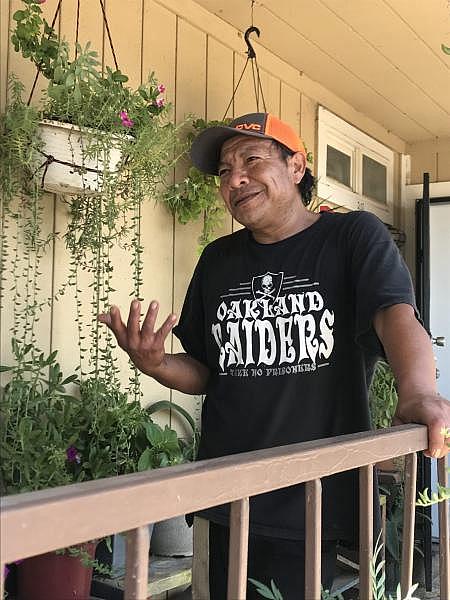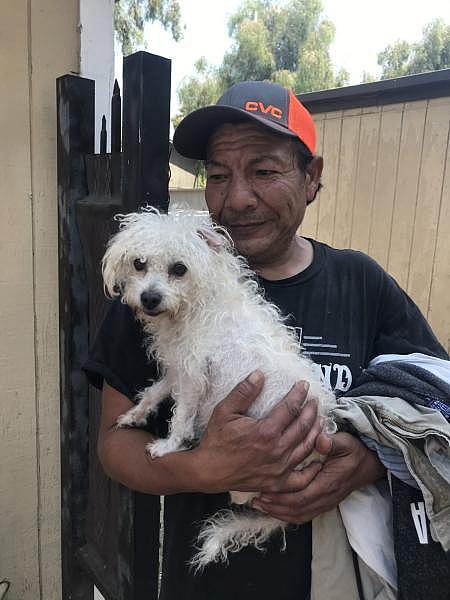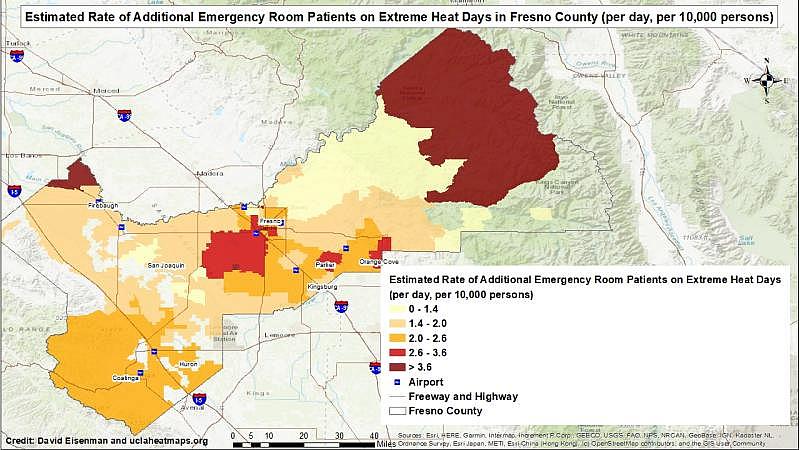Fresno County heat waves will last longer in the future. Here’s what that means for your health
The story was originally published in Fresnoland. with support from the USC Annenberg Center for Health Journalism's 2022 California Fellowship.

Fresno County broke record heat as a heatwave scorched the valley in the summer of 2020
Credit: Larry Valenzuela
What's at stake: The Fresno area will experience around 10 additional days a year over 100 degrees within 15 years, if greenhouse gas emissions aren’t reduced and vulnerable communities will be particularly at-risk for heat-related illnesses.
Under the overhang of an apartment complex on the border of Fresno and Calwa, Guillermo Hernandez and two neighbors sat beside a small garden where he grows Cat Paw, a plant he uses as an herbal remedy for cancer. It was 4 p.m. and 100 degrees on that June 28 afternoon.
Sitting just outside the sun’s reach was better than sitting inside, Hernandez said.
Inside, the heat was smothering; there was always a chance of a breeze outside, at least. Hernandez’s apartment has air conditioning, but the cost keeps him from using it most of the time. He said that even when he runs the AC, it does not stay cool inside for too long after he turns it off because the walls of the old apartment building are thin.
“Nos aguantan el calor. Que vamos hacer?” “We endure the heat. What else are we going to do?” Hernandez said.
In mid-July, Hernandez said he was hospitalized after fainting. He said his doctor told him he needs to stay out of the heat due to the medication he takes so now he tries to stay out of the sun and runs the AC more, despite the cost.
“With the heat, I have to go to hospital. If I start sweating a lot, I go to hospital,” he said. Later adding, “Sometimes it’s too hot to rest (inside the apartment).”

Guillermo Hernandez, a maintenance worker and renter, stands outside of his second-story apartment amidst his plants. The greenery stands out against an otherwise dry, tan-colored landscape.

Guillermo Hernandez, pictured here with one of his two dogs, was told by his doctor that he needs to stay out of the heat because of the medication he takes. However, the high cost of AC and thin apartment walls makes it difficult to stay cool indoors.
Courtesy of Monica Vaughan.
Hernandez is one of many Fresno County renters vulnerable to extreme heat with little to no relief. As temperatures continue to rise globally as a result of greenhouse gas emissions, Central Valley residents, like Hernandez, will face detrimental health impacts.
In 2021, the Fresno area experienced 69 days over 100 degrees – a record-breaking number of days, according to data from the National Weather Service. There have already been more than 50 days over 100 this year.
Fresnoland spoke to more than 40 renters and members of the unhoused community throughout the Fresno area about how exposure to prolonged heat already affects their health and daily life. Those interviewed reported a range of symptoms – from fainting and vomiting to anxiety and sleeplessness. Data and health experts backup their stories.
In Fresno County last year, there were 349 heat-related emergency calls to 9-1-1; heat was also listed as a cause of death for six people, according to data from the California Department of Public Health. So far this year, there have already been more than 200 heat-related emergency calls, according to data from the Fresno County Emergency Medical Services.


Maps showing were there have been 9-1-1 calls for heat related emergencies in 2021 and 2022. In 2021, there were 349 heat related emergency calls, and as of August 12, there have been more than 200 heat related emergency calls this year. Courtesy of Fresno County Emergency Medical Services.
Those numbers will likely grow in the coming years as the Central Valley is expected to see more extreme heat days and longer heat waves as a result of climate change. Communities who do not have access to indoor cooling or can’t afford the cost will be disproportionately impacted by the heat.
“Oftentimes when we think of adverse climate events, we think about hurricanes and tornadoes,” said Dr. Jesus Rodriguez, a family medical physician with Kaiser Permanente. “But really, heat waves are probably the most deadly of the environmental catastrophes that occurred over the years, at least in the last decade.”
What will Fresno area summers look like in the future?
Current climate models estimate the Fresno area will experience around 10 additional days a year over 100 degrees and 20 additional days over 90 degrees within 15 years, if greenhouse gas emissions aren’t reduced.
Those numbers will continue to increase, according to a high emissions scenario using data from Cal Adapt, a data and climate modeling tool developed by UC Berkley’s Geospatial Innovation Facility.
“Kids that are born today are still going to be in the school system by the time that we’re looking at these projections,” said Rae Spriggs, manager of Climate Action Research at the Luskin Center.
How does the heat impact health?
Extreme heat days and prolonged heat waves can create serious health concerns immediately and long term.
Heat can cause a person to lose the ability to regulate their body temperature, a condition known as heat stroke, which can result in death in severe cases, according to Dr. Rais Vohra, a UCSF professor and interim Fresno County Health Officer. Heat exhaustion, heat cramps and dehydration are other heat-related illnesses that can lead to hospitalization.
Even 90 degree temperatures for long periods of time can cause long term issues. Heat can make it difficult to sleep which affects a person’s health, it can lead to mood swings and present complications for people with preexisting health conditions like kidney failure and cardiovascular diseases, Vohra said. A 2021 study found that co-occurrence of heat and poor air quality compound the dangers for those with respiratory illnesses.
“When (a body’s) equilibrium goes awry, if it happens very slowly, no one tends to notice it,” Vohra said. “I think that the real kind of pernicious dimension of climate is that it can happen in such slow motion that even though many hundreds or thousands of people are affected, it takes years, and no one notices.”
Vohra is part of the Fresno Understands Environmental Resilience Through Equity (FUERTE) project which studies how climate change will affect Central Valley residents. The Fresno Madera Medical Society received funding for FUERTE from the California Resilience Challenge Grant after the Fresno County Board of Supervisors declined the grant, saying there was no need for the study.
The FUERTE study could help show how the healthcare system will need to adapt, especially as climate events such as more frequent heat waves are expected to lead to more hospital visits.
“Whether it’s heat or anything related to climate, or even wildfires, it’s going to first show up as more people coming in through the front door of the emergency department, sometimes of the primary care clinics,” Vohra said.
He added that the increasing climate emergencies has the potential to overwhelm the healthcare system in the way it was during the surges in COVID-19 cases.

Northeastern areas in Fresno County and some of northwestern Fresno County on average had the highest rates of additional emergency room visits on extremely hot days in Fresno County between 2009-2018. Courtesy of Dr. David Eisenman.
Fresno County recorded an annual average of 182 excess visits to the emergency rooms on high heat days between 2009-2018, according to a study by the UCLA Fielding School of Public Health and UCLA Center for Public Health and Disasters. The north eastern and northwestern corner of Fresno County saw the highest average rate of excess emergency room visits due to heat, the study shows.
The study considered both acute symptoms like dehydration and electrolyte imbalance and chronic heat related symptoms, such as kidney disease, cardiovascular disease and respiratory illnesses.
Whose health is most affected by heat?
Anyone who has lived in Fresno during one of its heat waves has felt uncomfortably hot, but some residents do not have the luxury of retreating to an air conditioned home or space.
Local researchers and health officials said those who live in Fresno may be more adapted to the heat than visitors or newcomers. However, as heat waves last longer, defenses weaken. The elderly, children, people who have pre-existing health conditions or disabilities, as well as those who work, exercise or live outside, are particularly vulnerable.
“Communities can be right next to each other and have very different levels of harm that comes from heat; and that has a lot to do with socio economic differences, disparities and housing,” said Dr. David Eisenman, director of the UCLA Center for Public Health and Disasters.
People are at higher risk during extreme heat events when they don’t have access to indoor cooling, when there is less tree canopy to shade homes and sidewalks, when there is less access to health insurance or healthcare and when high polluting industries are near people’s homes, Eisenman added.
A 2021 UC Davis study analyzed 20 Southwestern metro areas in the United States, including Fresno, from 2013-2019 and found that on average, the 10% poorest neighborhoods in an urban area were 4 degrees hotter than the wealthiest 10% areas in that same region.
Dr. Mackenzie Yore, a UCLA National Clinician Scholar and UCSF resident working with the FUERTE Project, called the disparities of climate change “a global phenomenon.”
“Communities that are most heavily impacted by the effects of climate change are No. 1 on a global scale, the communities that did the least to contribute to climate change as a problem,” Yore said. “And the effects are also impacting the communities that have the fewest resources to protect themselves.”
A study by American Forests found that Fresno’s whiter and wealthier areas have much more tree cover than the city’s poorer areas and that most of south Fresno, has very little tree canopy or greenspace.
“While we don’t have a lot of control over the changing climate at the moment. What we do have control over is the hyper local area of how you can mitigate it and how you could adapt.”
Jake Dialesandro, UCLA Luskin Center postdoctoral research fellow.
The lack of public areas to cool down is especially challenging for people who are unhoused, don’t have air conditioning, or can’t afford the high electricity bill.
Dozens of unhoused residents told Fresnoland that there is often no escape from the heat, and water can be difficult to come by.
Mike, an unhoused man who did not provide his full name, said that one afternoon roughly two months ago, he vomited and eventually fainted as a result of the heat. He came to in the shade of the tree he fainted under and was never hospitalized.
He said to stay cool he tries to “buy a drink and try to sit in (a restaurant) for as long as you can.”
Cooling centers are few and far between throughout Fresno County, and even within the cities of Fresno, Clovis, Sanger and Kingsburg transportation and knowledge of when they are operating can be a challenge.
And while many renters in Fresno have access to some cooling, those who spoke to Fresnoland, including Hernandez, said the cooling system provided in their units are outdated, ineffective and costly. Two people who spoke to Fresnoland said their air conditioners were broken for more than a week during triple digit heat.
What can be done to protect health during heatwaves?
Dozens of Fresno renters and unhoused residents said they needed information on cooling centers, more cooling centers, public drinking water access, and renter protections related to heat.
Even if greenhouse gas emissions were stopped altogether, people would still experience the effects of climate change, said Jake Dialesandro, a postdoctoral researcher with UCLA Luskin Center who worked on the Healthy Places Index:Extreme Heat Edition and UC Davis thermal inequity study. Still, there are ways to mitigate future impacts of climate change and protect people’s health.
Fresnoland will be diving deep into how the impacts of prolonged heat waves and extreme heat has impacted the health of vulnerable communities in Fresno County and the city of Fresno, the lack of current protections against heat and potential solutions that could help people stay healthy.
“While we don’t have a lot of control over the changing climate at the moment,” Dialesandro said, “what we do have control over is the hyper local area of how you can mitigate it and how you could adapt.”
The story is part of a series reported with support from USC Annenberg Center for Health Journalism’s 2022 California Fellowship program, with engagement support from the center’s interim engagement editor, Monica Vaughan.
